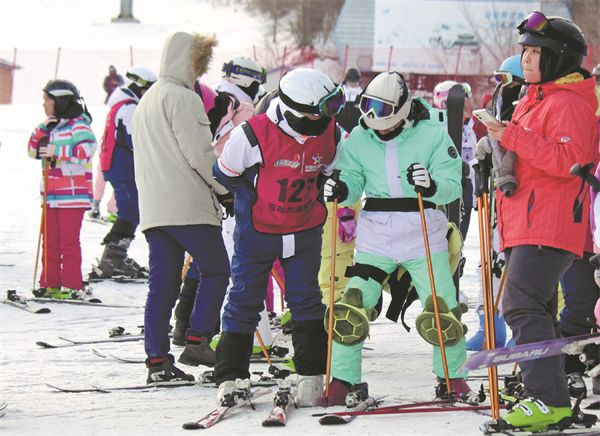
Ski enthusiasts gather at a venue in Harbin, capital of Heilongjiang province, on Dec 12. [Photo/China Daily]
Key related industry clusters driving more tourists to popular winter destination.
Ban Ruiqi and her family recently took a trip to Harbin in Northeast China's Heilongjiang province. Despite the extremely cold weather there, the tourists from Beijing skied, shopped and generally had a good time during the three-day New Year holiday.
"We went to the Chinese-Baroque Historic Block in the morning, and the Harbin Ice and Snow World in the afternoon, where I saw some local souvenirs and specialties. I bought some for my friends and relatives back home. I especially liked the hand-drawn postcards," Ban said.
As an increasing number of travelers show greater enthusiasm for winter tourism, Harbin's ice and snow economy is booming.
With the opening of various ice and snow-themed parks, the city has become popular among tourists.
In the two weeks since the opening of the Harbin Ice and Snow World on Dec 18, the city's popularity in searches on China's travel website Mafengwo surged 300 percent, making it an "internet celebrity" city, data from the online platform showed.
According to Harbin Taiping International Airport, the airport realized an annual throughput of 20 million passenger trips on Dec 20, setting a record for the Northeast China region.
A report released by online travel agency Ctrip showed Harbin ranked on a list of hot New Year holiday tourism destinations in China this year.
During the three-day holiday period, air and train ticket bookings to Harbin grew by 631 percent year-on-year.
The Harbin airport added 11 domestic routes, and operated 463 flights, on Dec 22, transporting over 70,000 passengers, setting a record for passenger flow.
On Dec 26, hotel bookings in Harbin for the New Year holiday on Beijing-based online travel agency Qunar surged 2,570 percent on a yearly basis, while those for bed-and-breakfast stays on homestay platform Tujia soared 2,700 percent.
"Entering the winter peak season, especially after the opening of the Harbin Ice and Snow World, our room reservations have remained full, and the situation will last until the Spring Festival period," said Deng Yibo, general manager assistant at the Modern Hotel in Harbin.
"Tourism souvenirs have mostly been sold out, especially hand-drawn postcards. Postcards of various tourist spots are popular; so are candies and chocolates from Russia. The shelves are basically empty," said Meng Fanbo, a staff member at a gift shop in Harbin.
Wang Hongxin, head of the bureau of culture, broadcasting, TV and tourism of Harbin, said, "The winter tourism season in Harbin has been so popular that we expect such a 'heat' will last until the end of March."
In January 2023, the China Tourism Academy issued a report on the development of Harbin's ice and snow tourism.
It said that with a high concentration of ice and snow resources in China, Harbin has gone through the primary stage of serving human transportation through ice and snow, and entered the advanced stage of using ice and snow resources to drive urban development.
In May 2022, Harbin launched a development plan for its ice and snow economy.
According to the plan, by 2025, total output value of the city's ice and snow industry should reach 75 billion yuan ($10.5 billion), taking up over a quarter of the province's total in the sector.
By 2030, that should take up over a third of the province's total and surpass 150 billion yuan.
Huang Dawei, deputy head of the bureau of culture, broadcasting, TV and tourism of Harbin, said, "Through coordinating the development of four key ice and snow industry clusters — ice and snow sports, ice and snow culture, ice and snow equipment, and ice and snow tourism — Harbin was successfully granted the right to host the 9th Asian Winter Games 2025."
Hong Yong, an associate research fellow at the e-commerce research institute of the Ministry of Commerce, said: "Harbin's ice and snow economy is on the rise, bringing real benefits to the local merchants.
To promote the long-term development of the industry, it is suggested that the government offer more favorable policies, such as helping lower merchants' winter operating costs, and providing marketing platforms. Meanwhile, enterprises should offer high-quality goods and services to meet consumer demand against the backdrop of a consumption upgrade."
